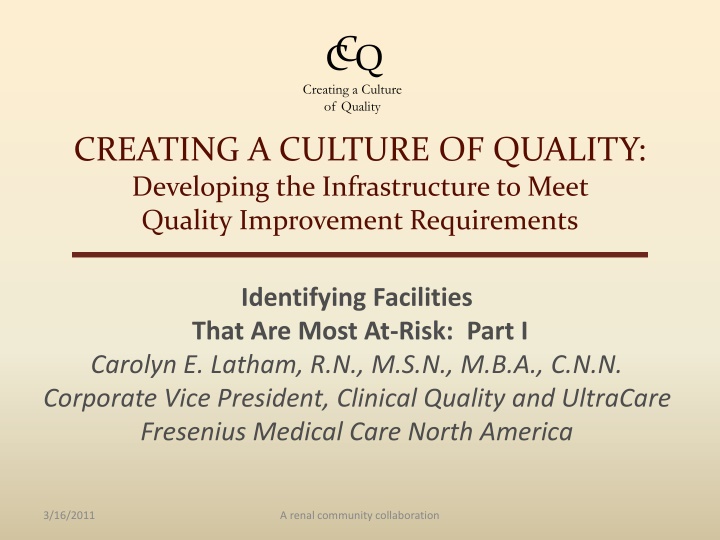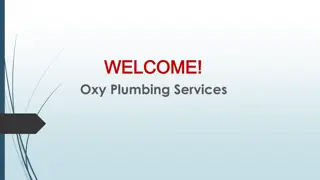
Developing a Quality Improvement Infrastructure for Renal Care
Explore the essential components of Quality Assessment and Performance Improvement (QAPI) in renal care facilities, focusing on effective drivers and common barriers at the local level. Learn about identifying at-risk facilities, measuring outcomes, and fostering a culture of quality to enhance patient care and operational effectiveness.
Download Presentation

Please find below an Image/Link to download the presentation.
The content on the website is provided AS IS for your information and personal use only. It may not be sold, licensed, or shared on other websites without obtaining consent from the author. If you encounter any issues during the download, it is possible that the publisher has removed the file from their server.
You are allowed to download the files provided on this website for personal or commercial use, subject to the condition that they are used lawfully. All files are the property of their respective owners.
The content on the website is provided AS IS for your information and personal use only. It may not be sold, licensed, or shared on other websites without obtaining consent from the author.
E N D
Presentation Transcript
CCQ Creating a Culture of Quality CREATING A CULTURE OF QUALITY: Developing the Infrastructure to Meet Quality Improvement Requirements Identifying Facilities That Are Most At-Risk: Part I Carolyn E. Latham, R.N., M.S.N., M.B.A., C.N.N. Corporate Vice President, Clinical Quality and UltraCare Fresenius Medical Care North America 3/16/2011 A renal community collaboration
QAPI Impact on Facilities at Most Risk External CMS, ESRD Networks CMS QAPI Requirements Program Scope Data driven Medical Director & IDT Network Relationships Regulatory Surveys Monitoring & Reporting Network Relationships QAPI Internal Oversight & Support: Regional, Divisional, Corporate Internal Local Facility QAPI: Structure, Processes & Oversight CCQ Creating a Culture of Quality 3/16/2011 A renal community collaboration
Question The most significant driver(s) of effective QAPI at the local level? a. Engaged Medical Director b. Clinical Manager with skill in QAPI c. Team involvement in QI d. Quality culture e. Management commitment f. All of the above g. None of the above CCQ Creating a Culture of Quality 3/16/2011 A renal community collaboration
FMCNA Facility-Based QAPI Patient Outcomes Internal & External Surveys Network Relationships Infection Surveillance Patient Safety Medical Records Quality Tools: Quality Reports Calendar Meeting Minutes Action Plans Tracking Tools Interview Guides Audits Documentation Observational CQI and Certification Certification, & Recognition Improvement, Equipment & Maintenance Water Systems Emergency Preparedness Patient Satisfaction Facility Operations CCQ Creating a Culture of Quality 3/16/2011 A renal community collaboration
Question The most common barrier(s) to effective QAPI at the local level: a. Insufficient knowledge & skill in QAPI b. Lack of a quality culture c. Inadequate QI tools and resources d. Lack of management commitment e. All of the above f. None of the above CCQ Creating a Culture of Quality 3/16/2011 A renal community collaboration
Identifying Facilities That Are Most At-Risk Ongoing Measurement Periodic Assessments Ongoing Reporting & Tracking CCQ Creating a Culture of Quality 3/16/2011 A renal community collaboration
Criteria Used to Identify Facilities That Are Most At-Risk Poor clinical quality outcomes Low total and subtotal quality scores Quality measures at action threshold High standard mortality rates Web-based results are visible to all levels of organization CCQ Creating a Culture of Quality 3/16/2011 A renal community collaboration
Criteria Used to Identify Facilities That Are Most At-Risk Poor results on in-person audits, assessments, reviews (internal) Ineffective QAPI processes (internal) CCQ Creating a Culture of Quality 3/16/2011 A renal community collaboration
Criteria Used to Identify Facilities That Are Most At-Risk CMS condition-level deficiencies (external) Network reviews (external) CCQ Creating a Culture of Quality 3/16/2011 A renal community collaboration
Criteria Used to Identify Facilities That Are Most At-Risk Major Positions Unfilled Governing Body Interdisciplinary Care Team QAI Team Inadequate Medical Director Support CCQ Creating a Culture of Quality 3/16/2011 A renal community collaboration
Criteria Used to Identify Facilities That Are Most At-Risk Adverse Events Concerns of reporting (i.e. under or no reporting) Unusual patterns Serious Adverse Events CCQ Creating a Culture of Quality 3/16/2011 A renal community collaboration
Criteria Used to Identify Facilities That Are Most At-Risk Biomedical Concerns Persistent Physical Environment Plant Concerns CCQ Creating a Culture of Quality 3/16/2011 A renal community collaboration
Criteria Used to Identify Facilities That Are Most At-Risk Complaints or Grievances Related to poor quality care, clinical performance, staffing, or physical plant issues Initiated by patients, patients significant others, staff, and/or physicians 3/16/2011 A renal community collaboration CCQ Creating a Culture of Quality
Question The most important determinant(s) of a facility at-risk: a. Poor clinical quality outcomes b. Higher mortality rates c. Clinical Manager opening d. Ineffective QAPI processes e. Lack of Medical Director leadership f. All of the above g. None of the above CCQ Creating a Culture of Quality 3/16/2011 A renal community collaboration


